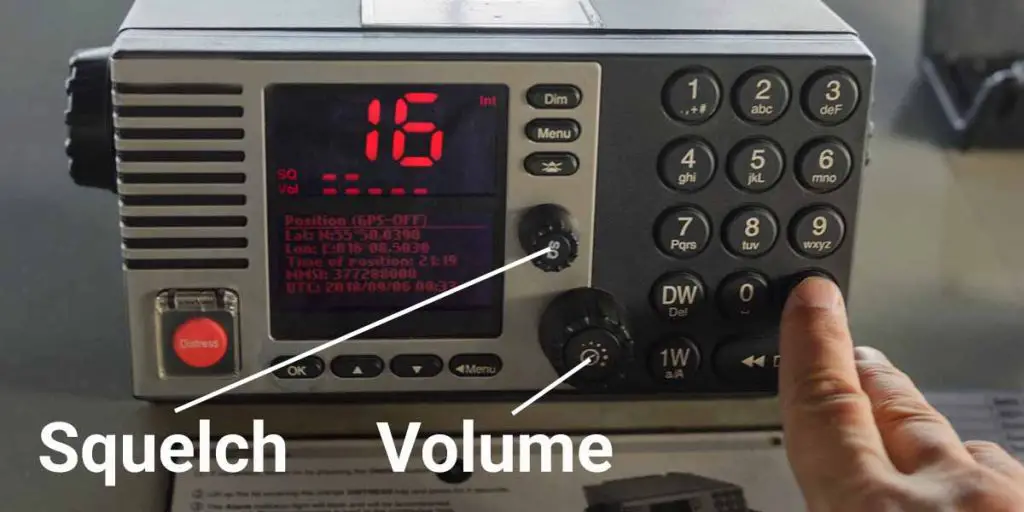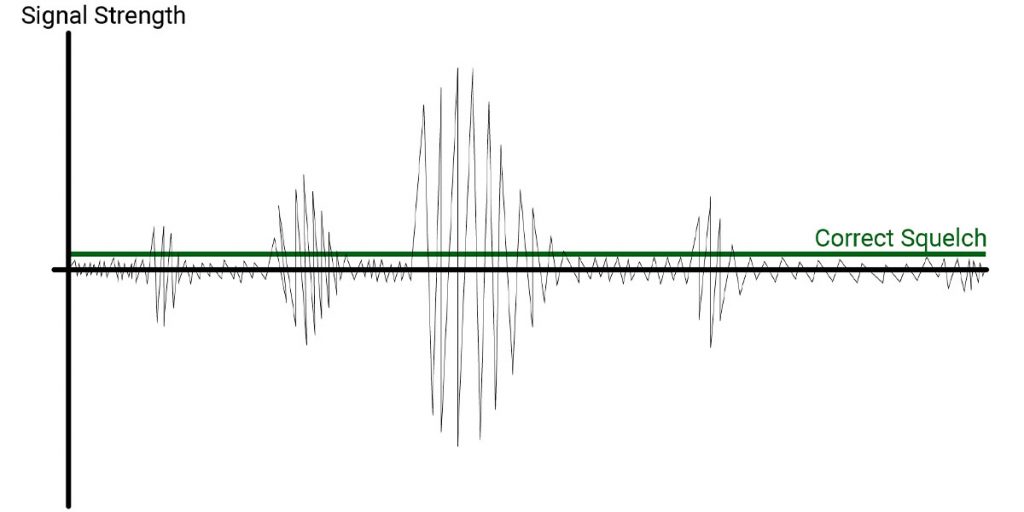How To Properly Adjust The Squelch On A VHF Radio
As an Amazon Associate, Casual Navigation earns from qualifying purchases.
On a VHF radio, the squelch allows you to reject unwanted static that would otherwise be broadcast through your speakers.
It improves safety by helping navigators concentrate, reduces VHF power consumption, and improves the experience of using VHF in general.
To get the most benefit, however, it is important to make sure your squelch is properly adjusted so that it rejects “unwanted” noise, but will accept voice transmissions, even if they are weak.
Fortunately, there is a simple 4-step process that you can follow to ensure your squelch is properly adjusted every time.
- Turn the volume and squelch all the way down
- Increase the volume until you hear background static loud and clear
- Increase the squelch until the point where the static stops
- Increase the volume again slightly to make sure transmissions will be heard clearly
On most radios, particularly fixed VHF units, there will be a manual “squelch” dial, so the adjustment can be performed with ease.
On others, often handheld VHFs, the squelch will be automatic, so you will not have any control over how it is set. With these sorts of radios, it is even more important that you understand how the squelch works, so you understand when (and why) your radio may not receive calls that you expect.
Pro Tip: Most handheld VHFs automatically adjust the squelch. My current favourite handheld VHF is the ICOM IC M73 (link to Amazon).
What is the Best Squelch Setting?
Squelch is a radio control that lets you mute the sound of background static coming out of a VHF speaker. Consequently, the best setting for your squelch is just above the level of that background static.

Setting your squelch high will mean that only particularly strong transmissions are able to break through the barrier.
Setting your squelch low will mean that transmissions need to carry less power to be able to break through.
This means that it is impossible to put an exact figure on the best squelch setting because it will vary depending on local conditions. The only way to properly adjust your squelch is to follow a step-by-step process to get it right.
4-Step Process For Adjusting The Squelch On A VHF Radio
Every navigator will have their own process for adjusting the squelch, but my personal favourite is a simple 4-step process.
Step 1: Turn the Volume and Squelch to Minimum

Start by turning both the volume and squelch down to their minimum setting.
Pro Tip: Always turn the volume down first because you will hear static when you turn the squelch down. If the volume is too high, you could damage your hearing or your speaker when lowering the squelch.
With the squelch right down, your radio speaker should emit every sound it receives. Unless there is a transmission in progress, this will only be any background static.
As your volume is right the way down, however, you shouldn’t hear anything until you move to step 2.
Step 2: Increase Volume
Now that your radio is playing everything that it is picking up, you want to increase the volume until you can clearly hear the background static.
This will give you enough sound to work with so that you set your squelch correctly in the next step.
You just want a level that is comfortable to listen to while you perform the rest of the adjustments.
Step 3: Increase Squelch
Now that you have background static giving you an indication of your radio’s volume, you can increase the squelch. Turn it up until you reach a point where the static only just disappears.

At this point, the radio is rejecting signals that are below the strength of the background static. Theoretically, any voice broadcasts will be more powerful, so they will break through the squelch threshold.
Pro Tip: Turn the squelch down a bit, and check you have the correct point multiple times to make sure you have it right.
Step 4: Final Volume Adjustment
Now that you know your squelch is set correctly, you need to increase the volume again to ensure you actually hear voice broadcasts through the speaker.
You don’t want to go too loud, but you want to make sure you’ll be able to hear every transmission loud and clear.
Remember, you may have been adjusting your VHF with your ear close to the speaker, so you will almost certainly need to increase the volume considerably.
For example, if you are on a sailing boat with the radio in the cabin, you still want to be able to hear it from the cockpit. Likewise, on a large ship, you want to hear the radio from across the wheelhouse.
Turn The Squelch Down In A Distress Situation
Although this entire article discusses squelch setting it correctly, if you hear someone broadcasting a distress message, you should ignore everything I have just said and make sure your squelch is turned down.
This is because you want to hear every broadcast that is made, even if you find it uncomfortable listening to the continuous hiss from your radio.
In a distress situation, the casualty may only have a weak handheld radio that might barely be discernable above the background noise. You don’t want your VHF rejecting it just because it is weak.
For example, you might see some flares and not realise someone is calling on VHF because your squelch is rejecting their call.
By turning down your squelch, whenever any signal comes through, no matter how weak, it will come through your speaker. As your VHF is now sensitive enough to play static, it will also be sensitive enough to pick up the weakest broadcasts.
Once the distress is over, however, you can readjust your squelch to make it comfortable again.
How Does Squelch Work?
The squelch control is just a noise gate that acts to reject weak signals. You set a threshold, and signals below that threshold are suppressed.

With marine VHF, the idea is that it suppresses the background noise. Background noise is normally a relatively weak signal compared to another VHF transmission. The squelch control just tells the radio to remain muted until a signal of sufficient strength is received.
When a signal breaks the squelch threshold, the radio unmutes itself and plays everything it can hear.
The VHF then normalises the sound to make it a consistent volume.
Assuming a transmission is significantly stronger than the level of background noise, you will only hear the transmission. If the signal is only marginally stronger than the background noise, normalising will amplify the noise as well as the transmission. The result is that the transmission sounds broken.
How Often Should You Adjust the Squelch?
You should adjust the squelch regularly, at least once every couple of hours.
It is a threshold setting that rejects background static, so you need to frequently check that it is correct. The level of background static is likely to change depending on any number of variables including:
- location;
- time of day;
- work occurring on board;
- weather.
There could even have been a consistent, weak broadcast taking place when you first adjusted the squelch. That would result in your squelch threshold being set too high.
A good rule of thumb is to adjust it every time you turn the radio on, and at least once per watch thereafter.
Pro Tip: If you have any reason to suspect a transmission is not coming through, it is a good idea to readjust your squelch.
Does Squelch Affect Transmission?
Squelch only affects the signals that your VHF radio receives, not the transmissions that you send.
When you make a transmission, your radio broadcasts the same signal, regardless of your squelch setting.
The only way your squelch setting will appear to affect your transmission is if you do not receive a reply. When you don’t receive a reply that you expect, you should always check both your volume and your squelch. If your squelch is set wrong, you may be rejecting the reply.
Likewise, other vessels receiving your transmission may not have their squelch set correctly. If their squelch threshold is set too high, they may not hear you.
The only way to break through someone else’s incorrect squelch is to increase the power of your transmission. Normally that is not possible, but it is worth checking that you are not on the “low power” setting.
Does Automatic Squelch Work?
Automatic squelch control (ASC) works by continuously analysing the signal/noise ratio. As background noise is fairly consistent, it just sets the threshold according to that consistent level.
In my experience, automatic squelch does work quite well.
Its biggest limitation is when there are very weak radio transmissions in the area. The threshold will be set according to the background noise, but a weak transmission could still exceed that threshold. Even if the transmission is so weak that it only sounds like noise, it will still be played.
I hear this quite a lot on my handheld VHF. Other people on handheld radios produce enough signal to exceed the ASC threshold, but not enough to hear their transmission clearly. The result is that my radio sometimes cuts in, just playing noise through the speaker.
